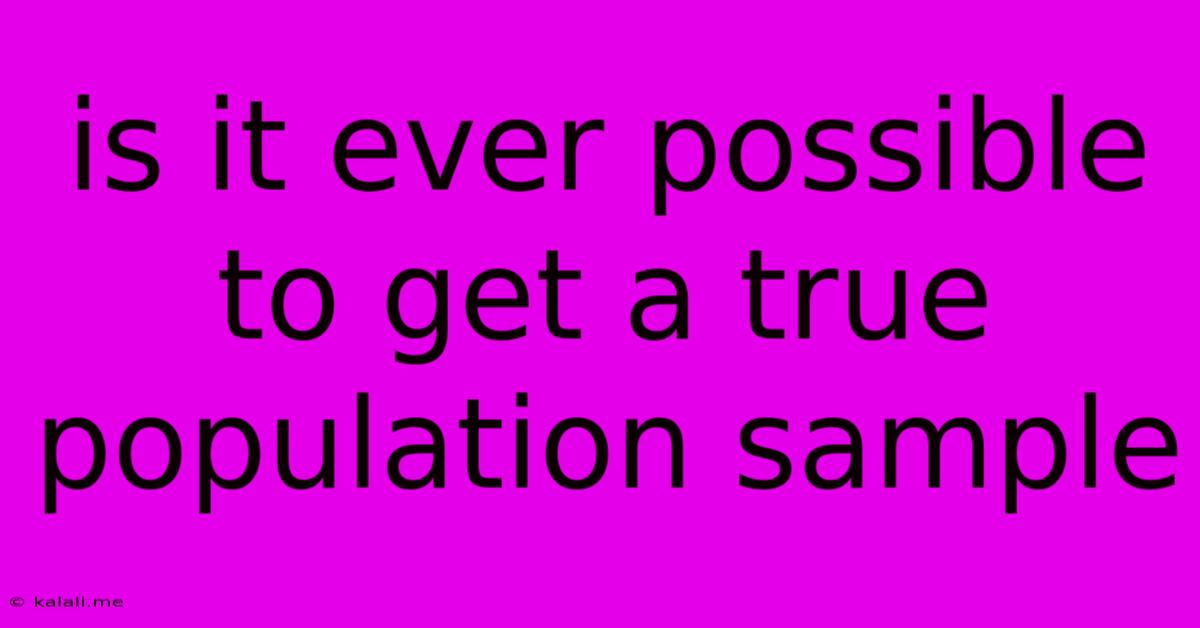Is It Ever Possible To Get A True Population Sample
Kalali
Jun 04, 2025 · 3 min read

Table of Contents
Is It Ever Possible to Get a True Population Sample? The Challenges of Perfect Representation
Getting a truly representative sample of a population is the holy grail of research. But is it even possible? The short answer is: no, not perfectly. While we can strive for accuracy and minimize bias, achieving a sample that perfectly mirrors the entire population is exceptionally difficult, if not impossible, especially with large populations. This article explores the challenges involved and delves into the strategies used to get as close as possible to a true population sample.
The ideal scenario involves selecting a sample where every member of the population has an equal chance of being chosen – a concept known as random sampling. This ensures the sample’s characteristics closely reflect the population’s characteristics. However, even with random sampling, several factors can introduce error and bias:
The Challenges of Obtaining a True Population Sample:
-
Accessibility: Reaching every single member of a population is often impractical, if not impossible. Consider a global survey; reaching remote or marginalized communities presents significant logistical and financial hurdles. This inherent inaccessibility introduces sampling bias. Even seemingly straightforward populations like registered voters can be challenging to reach completely – some might have moved, changed their contact information, or simply refuse to participate.
-
Sampling Frame Issues: The sampling frame is the list from which you draw your sample. Inaccuracies or biases within the sampling frame will directly affect the representativeness of your sample. For example, if your study relies on a phone directory, it inherently excludes people without landlines or those who choose to withhold their information. This introduces sampling error that can significantly skew results.
-
Non-response Bias: Even with perfect sampling methods, non-response bias remains a significant problem. Individuals who choose not to participate in a study may differ systematically from those who do, leading to biased results. This is particularly problematic in sensitive topics where certain demographics may be more reluctant to respond honestly.
-
Sampling Error: Even with the best-laid plans, random variation will always exist. Pure chance can lead to a sample that doesn't perfectly reflect the population. This is simply a fact of life in statistical sampling. Larger sample sizes help to minimize sampling error, but it can never be completely eliminated.
-
Defining the Population: Precisely defining the population of interest itself can be surprisingly challenging. The criteria for inclusion or exclusion can significantly influence the results. For example, what constitutes a "young adult"? Are geographical boundaries clearly defined? The ambiguity in population definition introduces another layer of potential bias.
Strategies for Approximating a True Population Sample:
Despite the inherent challenges, researchers employ several strategies to maximize the representativeness of their samples:
-
Probability Sampling Techniques: Techniques like stratified random sampling (dividing the population into strata and randomly sampling from each) and cluster sampling (sampling clusters of individuals) help to improve the accuracy of representation, addressing some of the issues outlined above.
-
Increasing Sample Size: Larger sample sizes, while often more expensive and time-consuming, reduce the impact of random sampling error and increase the likelihood of a representative sample.
-
Weighting Data: Statistical weighting techniques can be applied to adjust for known biases in the sample, bringing the data closer to reflecting the characteristics of the true population.
-
Careful Survey Design: The design of questionnaires and interview protocols is crucial. Clear, unbiased wording and well-defined questions minimize response bias and increase the accuracy of responses.
Conclusion: The Pursuit of Perfection
While achieving a perfectly representative sample is an unattainable ideal, employing rigorous sampling methodologies and data analysis techniques allows researchers to obtain samples that provide reliable and valuable insights into the population of interest. Acknowledging the limitations and potential sources of error is crucial in interpreting research findings and drawing conclusions responsibly. The pursuit of a "true" population sample is an ongoing process of refinement and improvement in research methodology.
Latest Posts
Latest Posts
-
Whats A Word To Describe Someone Who Doesnt Have Class
Jun 06, 2025
-
Vader In Bacta Tank Rogue One
Jun 06, 2025
-
How Long Does Coleslaw Last In The Refrigerator
Jun 06, 2025
-
Does A Quarterstaff Use Dex Or Str
Jun 06, 2025
-
What Year Does Black Butler Take Place
Jun 06, 2025
Related Post
Thank you for visiting our website which covers about Is It Ever Possible To Get A True Population Sample . We hope the information provided has been useful to you. Feel free to contact us if you have any questions or need further assistance. See you next time and don't miss to bookmark.